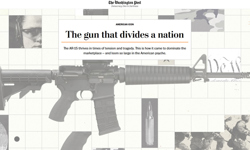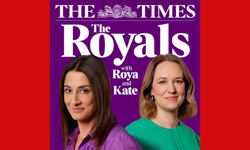Katie Vanneck’s job has to be one of the more interesting in the increasingly brutal national newspaper world. As group marketing director of the Daily and Sunday Telegraph, Vanneck oversees the various intertwining strands of the marketing department, including promotions, branding and communications. In addition to this, she is responsible for the newspapers’ substantial subscriptions activity (about one third of the Daily Telegraph sale is on subscription), for their customer management activity and for ‘customer touch points’ like the call centre. Clearly, this is a marketing role with teeth, and Vanneck seems happy with the challenge.
Vanneck is one of a new team at the Telegraph, and in February 2006 celebrated one year with the company. It is now just over 18 months since, on June 23rd 2004, the Telegraph newspapers were sold for £665m to the Barclay brothers, the billionaire owners of the Ritz hotel in London. The titles were part of Conrad Black’s Hollinger Group for the previous 20 years.
New management team
In September 2004, the Barclays appointed Murdoch MacLennan, formerly managing director of Associated Newspapers, to be their group chief executive. MacLennan quickly and dramatically reorganised Telegraph newspapers, reducing the headcount by 300, including 90 editorial staff (some 17% of the total) and made major changes to the management team, bringing in a diverse range of talent – John Allwood, Telegraph group managing director came from Orange UK where he was executive vice president; ex-press secretary to the leader of the opposition, Guy Black, has been appointed Telegraph corporate affairs director; Dave King, now Telegraph executive director, was formerly managing director of Emap Advertising; like Vanneck, Annelies van den Belt came from News International, where she was digital director of Times Newspapers and is now new media director of the Telegraph.
Editorially, MacLennan has also made some major signings with John Bryant, Telegraph editor-in-chief appointed from Associated Newspapers; Sarah Sands has been promoted from deputy editor of the Daily Telegraph to become editor of The Sunday Telegraph; William Lewis of the Times is now the Daily Telegraph’s city and deputy editor; Jeff Randal was the BBC’s business editor and is now editor-at-large and business writer; media coverage has been reinstated with the appointment of veteran commentator Roy Greenslade, formerly of the Guardian; Simon Heffer returns to the Telegraph from the Daily Mail as associate editor after an absence of ten years.
Vanneck, 32, started her career as a graduate trainee within the marketing department at News International, publishers of the Times and the Sun. She was fast-tracked, rising to marketing manager of the Times, subsequently becoming digital director of Times Online and then, at the early age of 28, promotions director of the Times and the Sunday Times. Already an industry high flyer, she has been selected to speak on digital innovation in June, at the World Newspaper Congress in Moscow, in the company of Vladimir Putin and Mikhail Gorbachev. (Sharing her platform will be her colleague at the Telegraph, Annelies van den Belt, who will be no stranger to Moscow having published the English-language newspaper there.)
Broadsheet vs compact
So, what is the plan for the Telegraph newspapers? While, in December 2005, sales volumes across the whole national daily newspaper market dropped by 2.63% year-on-year (with the ‘red-tops’ particularly hit), the quality daily sector was the only one to show any year-on-year growth in sales volumes; with the July to December 2005 ABC figures 1.1% up on 2004. Excluding bulks, the redesigned Daily Telegraph was 1.9% down year-on-year, clawing back share after a slump in October, when it was temporarily hit by the Guardian’s relaunch and resizing to the semi-compact ‘Berliner’ format. Although it is early days, the Guardian and Observer’s new formats appear to have been a success, with the Guardian’s December sale up by nearly 9% (year-on-year, excluding bulks) and the Observer having apparently stabilised its circulation. Given the apparent success of the Guardian’s new size and relaunch, and the compact status of the Times and the Independent, isn’t it time for the Telegraph to follow the trend? Or has this growth been the result of their free DVD promotions rather than format changes?
Vanneck supports free DVDs (‘part of the promotional mix’), but is assertively unconvinced about the need for a format change. She describes the many other initiatives that the Telegraph has taken: ‘we are positively investing in the newspapers. Our owners are businessmen and require that we maintain and grow our profitability, which we have – unlike our competition. But, they have also invested in a substantial relaunch programme, including new presses to give us much more colour (with a potential for 32 colour pages out of a 56 page book). While our format remains broadsheet, we have attractively redesigned the newspapers and launched a very successful compact daily ‘Sports’ section, which is achieving its purpose of attracting new younger readers to start buying it. The Telegraph has always had a widespread reputation for excellent sports coverage and we are building on that reputation. At the same time, we launched a new daily broadsheet ‘Business’ section, which has been very well received by our readers.’
‘In addition, we are investing in other access points’, continues Vanneck. ‘Entries to our Fantasy Football game are 20% up on last year and it’s attracting an audience with an average age of 34. Hosted by Alan Hansen, the product has developed online while integrating effectively with all our media – you can now play the game on your mobile across a wap protocol.’
Telegraph podcasts
The Telegraph is also developing its other digital media. ‘We are well known for having the UK’s first electronic newspaper but we are committed to our other digital media, such as podcasting’ (where audio files are downloaded on demand over the web). In less than two years, podcasting has gone from the periphery of the internet to a mainstream digital platform, with comedy radio shows accounting for a third of the top 30 podcasts on the iTunes ‘Top 100’. The Telegraph’s offering of a daily package of news and comment - presented and edited by former BBC Radio 5 Live presenter Guy Ruddle – often appears in the Top 10 download chart and is regularly the No 1 news download. As Vanneck states, ‘podcasting provides another platform for news exclusives; so far this year we’ve had exclusive podcast interviews with the new leader of the Conservative Party, David Cameron, and with intrepid rowers James Cracknell and Ben Fogle on their gruelling race across the Atlantic.’
So, no change to the size of the papers then? It would seem not. ‘We are proud and confident of our broadsheet format and will stay with it’, says Vanneck. ‘Our size and reach matches our status as the country’s best selling quality newspaper, and being the remaining broadsheet in the UK has a number of benefits. We are distinctive on the newsstand and, because of our size, we provide the best value and impact for our advertisers. We are happy not to risk such advantages, particularly while the long-term effects of a compact format are so uncertain.’
But, where are the papers headed editorially? Given the Barclays’ reputed admiration for the Daily Mail and all things Associated, the appointment of Murdoch MacLennan, the wholesale recruitment of editorial teams from Derry Street, and the relaunch, in October 2005, of the Sunday Telegraph firmly into the female marketplace, should we not be expecting a broadsheet clone of the Daily Mail?
The Telegraph reader
It is clear that Vanneck has given much thought to this, and, while she is convinced that she will pick up ‘disenchanted Daily Mail readers’, she has a much wider, more confident agenda. ‘We base our pitch to readers on the values we share, and not on their age or their imagined allegiance to polarised groups. Our readers are interested in society and in community and how we treat each other. A Telegraph person tends to believe in the ethic of self-provision and to cling to the issues of family responsibility, social cohesion and marriage.’ (Does that mean you are against civil partnerships for example? ‘No, the Daily Telegraph was the first newspaper to carry an announcement of a civil ceremony in its classifieds.’) Telegraph readers plan for the future, their education, pensions and retirement. They are ageless, they are grown up, they are moral.’
‘Telegraph people put a stringent value calculation on life – what they are getting for what they invest, from shop purchases to taxation. They buy from Millets, Marks and Sparks, WH Smith and John Lewis, and hold charge cards for department stores. They support the National Trust and the National Horticultural Society and love the BBC. (‘The Telegraph is the National Trust of newspapers.’) They particularly love Radio 2 – Terry Wogan, Jonathan Ross, Mark Lamarr and Chris Evans. Telegraph readers might be solicitors or taxi drivers. They will respond to Bill Deedes or to Zadie Smith (recruited to be the new film critic for the Sunday Telegraph). My mother and I can have the Telegraph in common.’
It’s an interesting vision. Vanneck sees a newspaper that crosses the divides of age, class, ethnicity and gender in a country that is increasingly multicultural and heterogeneous. Her readers are ‘grown up and moral’ (which my thesaurus describes as ‘ethical, good, right, honest, decent and proper’). Do we have a large group of people, within the UK, who are united by good manners and the good life rather than age or class or ethnic group? Can the Telegraph conduct a conversation with its readers that unites and reassures rather than divides and frightens? It seems a bold and exciting departure from the paper’s previous image and from the cynical world of newspapers generally, and is one whose evolution I will watch with fascination.
FEATURE
Managing transition at the Telegraph
The Telegraph has had a tumultuous time of late; new owners, new management, new editor and, agonisingly, a circulation dip below the magic million. Tony Coad meets group marketing director Katie Vanneck and hears an upbeat and optimistic view of the future for the UK’s last remaining daily broadsheet.










